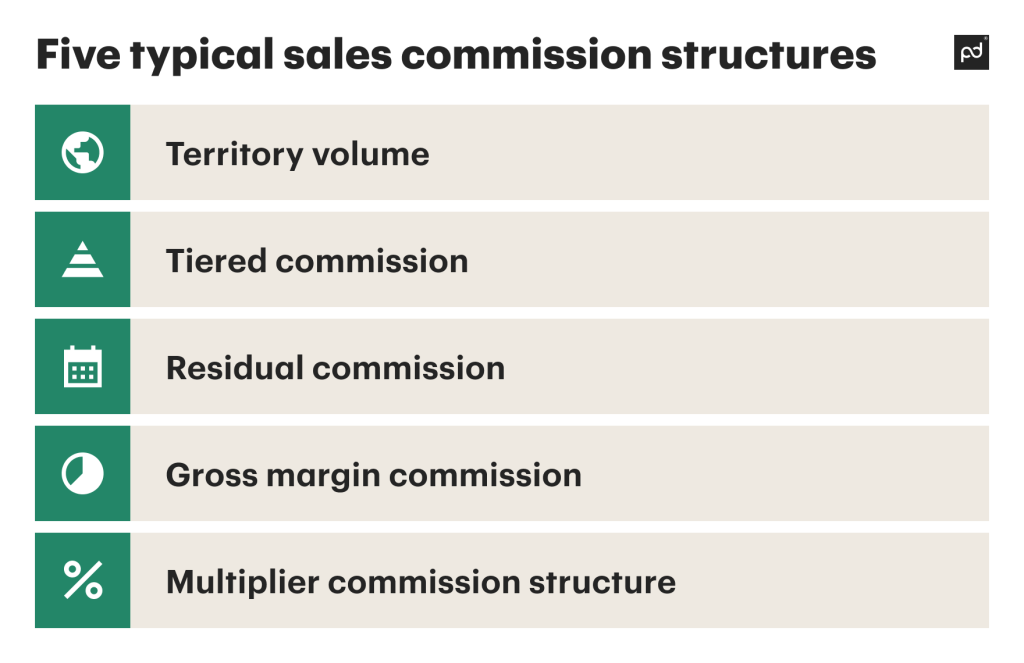A sales process is crucial to any commercial organization looking to secure revenue and grow.
To do so, you need to be able to attract top talent to succeed — just like with any other business department!
However, since sales activities have been notoriously hard to measure in terms of performance, many business owners have adopted various commission structures to keep their sales reps motivated.
So how do you strike a perfect balance between business goals and the compensation needs of employees?
Properly structured commissions, that’s how! Let’s dig in.
How does the commission structure work?
How your compensation package (including commission structure) works tells a great deal about your organization.
As such, your prospective employees will judge whether your company can be a good fit. Apart from that, commission is also a great motivator to drive more sales if it’s executed right.
You must find a middle ground, a path that provides your sales reps equal parts a sense of stability and a “hunger” for extra profit.
Depending on how experienced your sales team members are, they could opt for a base salary, higher commission rates, or something in between.
Selling is arguably a line of work where personal attachment matters the most.
So what can possibly be a better incentive than a performance-based bonus?
Now the question is, how do you set up a commission structure that works great for employees and employers?
Five typical sales commission structures

1. Territory volume
Territory volume is a commission paid off based on revenue from a specific region.
The commission is equally distributed between all sales reps assigned to a particular area.
So let’s assume that a team of three sales reps is supposed to drive $100k in revenue from a specific region.
One of them sells $50k, and the other two $40k and $30k, respectively. As a team, they generated $120k, exceeding the established quota of $100k.
Consequently, they’d split the 10% commission, each getting $4k.
2. Tiered commission
As the name suggests, this commission type is divided into different tiers, each marking a new sales goal reached.
The idea here is quite simple.
When a certain sales threshold is met, a rep is paid, say, 10% of the revenue generated.
Once another threshold is achieved, the commission fee is bumped up to 15%, and so on.
With a tiered commission, you can motivate your A-players to hit even bigger and more ambitious sales targets.
3. Residual commission
This commission “resides” for as long as client accounts are alive and well.
Here is how a residual commission works: a marketing firm receives a large monthly client account that generates $5k in revenue.
As long as this account is active, the sales rep responsible for that account gets a 5% commission every month.
4. Gross margin commission
Gross margin commission is paid on the margin from selling specific goods and services.
It is designed to prevent sales representatives from using discounts too often, as the commission is tied to the final cost.
For instance, let’s say it costs $600 to produce a TV set that is sold at $1000 retail. The margin is $400, and a commission will be paid on that.
5. Multiplier commission structure
Not all sales representatives are high-caliber pros, and not reaching the quota can be a devastating blow to the confidence of aspiring sales representatives.
Sometimes, a commission can be paid when a result close to the intended goal has been met.
A multiplier commission structure is paid depending on the percentage of targeted quota achieved: if 80% of the quota is reached, the commission is 5%; for 90%, the commission rate is 6%, etc.
Why do you apply sales commissions?
Salary combined with a performance-based bonus is popular among employers and employees.
That is a great way to provide your employees with the assurance of steady income yet keep them motivated at the same time.
The most common ratio is 60 to 40, where 60% is a salary base. Here are some additional examples of why you structure commissions, depending on your specific objective:
You want to encourage teamwork
It’s always great when healthy competition within your sales team exists.
However, if your sales team is entirely made up of individuals who only care about themselves, that will probably not work in the long run.
Furthermore, that creates a somewhat unhealthy vibe within the sales department.
Making your sales department function as a whole can be achieved by tying commission to the team’s performance rather than on the individual level.
This means the commission is paid once the team reaches a certain benchmark (e.g., exceeding the sales quote for a region).
Territory volume commission is great for lifting team spirit.
Although it implies that you have people on your team with a developed sense of personal responsibility, it also sets the stage for potential freeloaders to abuse this type of commission structure (but they’ll likely show their true colors soon enough, and can be weeded out accordingly).
You want to motivate top performers
How can you motivate sellers already performing at the top of their game? Well, offer more and bigger incentives!
To do so, you can draw inspiration from the experience of fiscal services (like structured tax rates) — using a progressive scale.
That is exactly what tiered commission is made for!
However, if you want to keep your top performers motivated yet encouraged to use only those sales tools that do not lead to providing discounts, opting for a gross margin commission is a good choice.
Also, you shouldn’t forget about your junior sales reps — consider offering them a multiplier commission!
Using these commission types is great if you’re looking to scale your sales operations without increasing your headcount substantially.
Your sales reps are forced to think creatively and explore all possibilities of getting the most out of available assets (e.g., upselling, cross-selling, loyalty programs, special offers, etc.).
You need to increase lifetime value (LTV)
Attracting a new client can cost 5 to 25 times more than retaining an existing one.
If your business operates in a niche where new clients are rare, you need to work out a commission structure that will serve this purpose accordingly.
Luckily, there is one that will help you achieve just that.
So how do you encourage your sales reps to keep your client accounts alive and well?
Obviously, you can’t do that with a one-time commission fee.
Instead, consider paying your sales reps a monthly residual commission while the accounts they manage are active.
That will broaden client relationships beyond the initial account acquisition.
The monthly amounts can’t be as large as a one-time commision.
However, the prospect of losing a stable part of a monthly revenue will encourage your sales reps more than anything to capitalize on positive client connections, increasing the longevity of your client accounts.
Why is a commission structure so crucial to your business?
Sometimes, you have to invest first in certain assets to increase your business revenue.
One of the most critical to achieving steady growth and consistent success is your employees.
In fact, paying competitively can decrease sales turnover by as much as 50%.
Given how much effort goes into hiring and training new sales reps, you end up saving substantially in the long run.
Simply put, pick a commission structure that fits your business goals! We’ve provided some of the most common commission structures above, although the list doesn’t end there.
The bottom line is to make it work effectively, and you need to figure out the right mix of salary, commission, and quotas.
Chosen wisely, sales structures that benefit your employees (who will feel they are treated fairly) will motivate them to go the extra mile, driving more revenue and benefiting your business.
Time is money — and must not be spent recklessly
Each sales prospect ideally wants to see a proposal from you (which can easily get forgotten or rejected, or you may determine the potential rep simply isn’t a good fit for your company before they even start).
Preparing proposals can be a total bummer when you realize how much of this work may go into nothing.
So why not make your life easier with PandaDoc?
You’ve got a quote builder, hundreds of pre-built templates, and analytics — everything you need for top-performing sales teams!
On top of that, PandaDoc integrates with many of the tools you already love, such as HubSpot, Zoho, Zapier, Stripe, and dozens of others. Check it out!
Disclaimer
PandDoc is not a law firm, or a substitute for an attorney or law firm. This page is not intended to and does not provide legal advice. Should you have legal questions on the validity of e-signatures or digital signatures and the enforceability thereof, please consult with an attorney or law firm. Use of PandaDocs services are governed by our Terms of Use and Privacy Policy.
Originally published October 4, 2017, updated April 26, 2023


